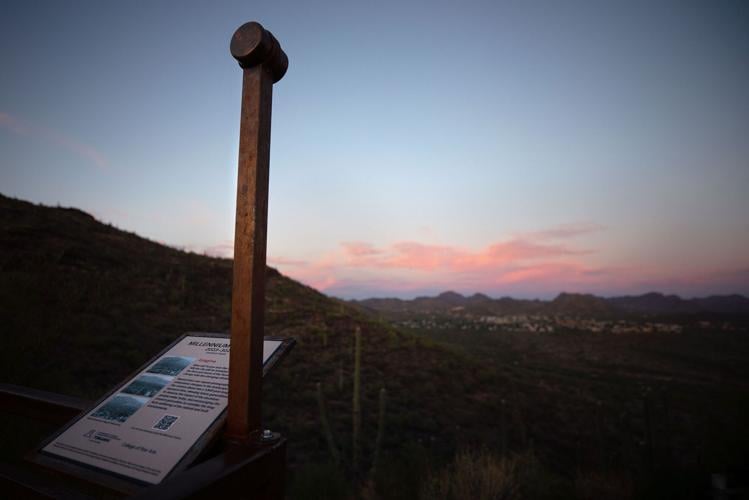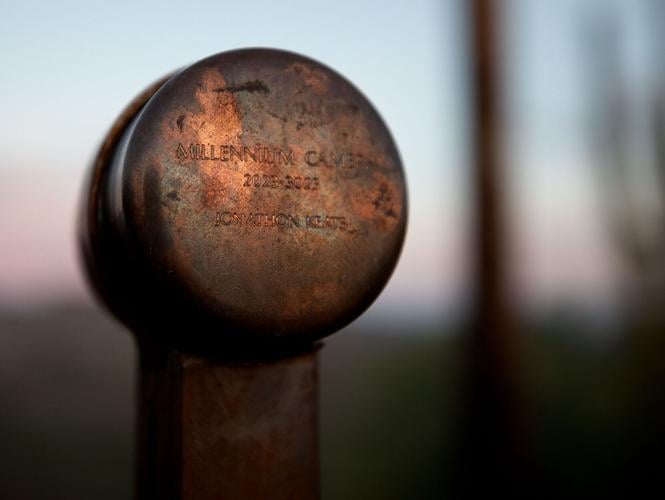No one knows exactly what will happen to Tucson or the desert surrounding it over the next 1,000 years, but a new art project on Tumamoc Hill could offer a pretty good snapshot someday.

The Millennium Camera stands where Tumamoc’s popular walking path winds past the Desert Lab buildings about half way up the hill Friday. The camera is designed to record a continuous, “deep-time-lapse” photograph of the evolving view from Tumamoc, as human development, climate change and other factors transform the landscape. The experimental philosopher and artist, Jonathan Keats, came up with the idea.
The Millennium Camera is designed to record a continuous, “deep-time-lapse” photograph of the evolving view from Tumamoc, as human development, climate change and other factors transform the landscape.
The idea is the brainchild of Jonathon Keats, an accomplished artist and self-described experimental philosopher whose wide-ranging interests include humanity’s frayed connection to the natural world and the notion of long-term thinking in a society increasingly distracted by its own rapid advancement.
Keats called his handmade camera a “philosophical instrument for mental time travel.” He wants people to imagine what the finished photo might look like and how it will be received by the people who find it in a thousand years.
It’s a chance to examine our present from the perspective of someone living in the year 3023 and to think about how we can “make the picture look like what we would want them to see,” said Keats, who is a research associate with the University of Arizona’s Desert Laboratory on Tumamoc Hill.
In that way, the Millennium Camera is a “time capsule that’s self-fulfilling,” he said.
It was installed in early July, its aperture permanently open to the world and pointed west towards Starr Pass Resort and the Tucson Mountains.
The entire apparatus resembles a copper-colored sledgehammer that’s been bolted to a railing, along with an interpretive sign, where Tumamoc’s popular walking path winds past the Desert Lab buildings about halfway up the hill.
That location was chosen to take advantage of an adjacent bench where “people can sit, view the present landscape and contemplate possible futures, including future expansion of urban development,” Keats said.
Pinhole in time

Artist and experimental philosopher Jonathon Keats gives a workshop on pinhole cameras at the University of Arizona’s Desert Laboratory on Tumamoc Hill in May.
Eventually, he hopes to place a few more 1,000-year cameras on the hill, including one pointed east toward downtown Tucson, but those plans are contingent on additional funding.
His device is a resilient spin on the traditional pinhole camera. Light enters through a tiny opening punched through a thin sheet of gold and shines on a copper plate glazed with rose madder, a red pigment that fades gradually in sunlight.
Brighter objects in the frame will cause the pigment to fade more quickly, eventually producing a red and white positive image of the landscape in front of the camera.
After a thousand years, unchanging objects like mountains should be rendered clearly, while more temporary features like buildings will appear like ghosts as they rise and fall over the centuries.
Nothing so ephemeral as a person will show up in the image. Keats said anyone wishing to pose for a selfie in front of the Millennium Camera will have to stand there for a few hundred years in order to register at all.
“Anything that’s transient is not going to be recorded,” he said.
The barrel-shaped camera, roughly the size of a soda can, is crafted from materials that don’t rust or easily break down, and there are no moving parts. But even with all that engineering, Keats acknowledged that there is very little chance of successfully capturing a 1,000-year time lapse — or that anyone will recover the image some day.
What he is doing is as much of a philosophical exercise as a photographic one, he said.
The grant-funded project is a partnership between the U of A’s Arizona Institute for Resilience, the College of Fine Arts and the Desert Laboratory.
The new device on Tumamoc joins a growing Deep Time Photography network that already includes 1,000-year cameras in the Austrian Alps, the Nevada shore of Lake Tahoe, Amherst College in Massachusetts and overlooking Tempe from Arizona State University, where Keats served as an “Imaginary Fellow.”
In 2014, he oversaw the placement of 100 century cameras around Berlin in hopes of capturing 100-year-long exposures of the European city.

Artist and experimental philosopher Jonathon Keats, standing at left, gives a workshop on pinhole cameras at the University of Arizona’s Desert Laboratory on Tumamoc Hill in May.
In May of this year, he hosted a workshop at the boathouse on Tumamoc Hill to show people how to make their own pinhole cameras for taking very long exposures.
He said the more deep-time cameras that are deployed around the world, the greater the chance that at least a handful of them will survive so their images can be found and marveled at a few — or maybe even a few dozen — generations from now.
The long view
In the meantime, Keats is working on several other unusual, extremely long-range projects that blend art and science.
One involves planting an ironwood tree sapling on Tumamoc Hill and using its growth to measure time. He also wants to build a similar natural calendar in Nevada using the bristlecone pine, a species of tree with the longest known lifespan of any organism on Earth.
In both cases, Keats said, the clocks would tick in so-called “arboreal time,” which he expects to gradually diverge from our standard, Gregorian calendar due to growth fluctuations brought on by drought and other impacts of climate change. He hopes the resulting difference between nature’s calendar and the manmade one will prompt people to “reconsider time and place from the tree’s perspective.”
Keats has already partnered with the Anchorage Museum on a project called Alaska River Time, essentially a clock that speeds up and slows down with the flow of glacial and spring rivers in that state.
He was also the mastermind behind another public art project on Tumamoc Hill last year that invited visitors to wax poetic about the weather on slate panels placed along the walking path. That collaboration between the Desert Laboratory and the U of A Poetry Center was called “Future Climate Proverbs for a Changing Desert Environment.”
Clark Reddin is director of operations for the Desert Lab. He helped Keats put up the Millennium Camera on Tumamoc.

The Millennium Camera stands where Tumamoc’s popular walking path winds past the Desert Lab buildings about half way up the hill on Tuesday. The camera is designed to record a continuous, “deep-time-lapse” photograph of the evolving view from Tumamoc, as human development, climate change and other factors transform the landscape. The experimental philosopher and artist, Jonathan Keats, came up with the idea.
Reddin described his initial reaction to the project with one word: “wonderment.”
“I volunteered to be the person who takes the camera stock out in a thousand years,” he said with a laugh.
If he’s being honest, though, Reddin doesn’t think there’s much chance that the camera will actually last that long. The copper and steel frame holding it up will almost certainly corrode and collapse before the year 3023, he said.
But that’s not really the point. The camera is designed to engage the imaginations of people walking on Tumamoc Hill today, not whoever might stumble across it centuries from now, Reddin said.
“It’s asking people to think about their environment from a different perspective,” he said. “That’s really the value of it.”
A unique view of the city’s ecological wonder. It’s one of the area’s most popular hiking and running trails, with more than 700 feet of elevation change and a grand view of downtown.







